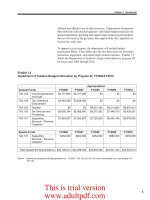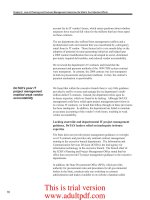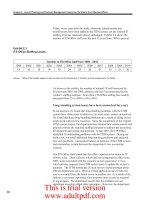Lecture Principle of inventory and material management - Lecture 10
Bạn đang xem bản rút gọn của tài liệu. Xem và tải ngay bản đầy đủ của tài liệu tại đây (979.03 KB, 62 trang )
Lecture 10
Materials Requirements Planning (Continued)
Books
•
Introduction to Materials Management, Sixth Edition, J. R. Tony Arnold, P.E., CFPIM, CIRM, Fleming
College, Emeritus, Stephen N. Chapman, Ph.D., CFPIM, North Carolina State University, Lloyd M.
Clive, P.E., CFPIM, Fleming College
•
Operations Management for Competitive Advantage, 11th Edition, by Chase, Jacobs, and Aquilano, 2005,
N.Y.: McGrawHill/Irwin.
•
Operations Management, 11/E, Jay Heizer, Texas Lutheran University, Barry Render, Graduate School of
Business, Rollins College, Prentice Hall
Objectives
•
•
•
•
•
MPR structure
Determining Gross Requirement
Net requirement plan
MRP and JIT
Lot sizing techniques
MRP Structure
Data Files
Output Reports
BOM
MRP by
period report
Master
production schedule
MRP by
date report
Lead times
Planned order
report
(Item master file)
Inventory data
Purchasing data
Material
requirement
planning
programs
(computer and
software)
Purchase advice
Exception reports
Order early or late
or not needed
Order quantity too
small or too large
Determining Gross Requirements
Starts with a production schedule for the end
item – 50 units of Item A in week 8
þ
Using the lead time for the item, determine the
week in which the order should be released
– a 1 week lead time means the order for
50 units should be released in week 7
þ
This step is often called “lead time offset” or
“time phasing”
þ
Determining Gross Requirements
From the BOM, every Item A requires 2 Item
Bs – 100 Item Bs are required in week 7 to
satisfy the order release for Item A
þ
The lead time for the Item B is 2 weeks –
release an order for 100 units of Item B in
week 5
þ
The timing and quantity for component
requirements are determined by the order
release of the parent(s)
þ
Determining Gross Requirements
The process continues through the entire
BOM one level at a time – often called
“explosion”
þ
By processing the BOM by level, items with
multiple parents are only processed once,
saving time and resources and reducing
confusion
þ
Low-level coding ensures that each item
appears at only one level in the BOM
þ
Gross Requirements Plan
1
2
3
Week
4
5
equired date
Order release date
50
equired date
Order release date
100
100
equired date
Order release date
150
equired date
Order release date
200
equired date
Order release date
300
200
600
300
600
300
300
300
300
equired date
Order release date
equired date
Order release date
6
200
200
150
7 8
50
Lead Time
1 week
2 weeks
1 week
2 weeks
3 weeks
1 week
2 weeks
Net Requirements Plan
Net Requirements Plan
Determining Net Requirements
Starts with a production schedule for the end
item – 50 units of Item A in week 8
þ
Because there are 10 Item As on hand, only
40 are actually required – (net requirement)
= (gross requirement - on- hand inventory)
þ
The planned order receipt for Item A in week 8
is 40 units – 40 = 50 - 10
þ
Determining Net Requirements
Following the lead time offset procedure, the
planned order release for Item A is now 40
units in week 7
þ
The gross requirement for Item B is now 80
units in week 7
þ
There are 15 units of Item B on hand, so the
net requirement is 65 units in week 7
þ
A planned order receipt of 65 units in week 7
generates a planned order release of 65
units in week 5
þ
Determining Net Requirements
A planned order receipt of 65 units in week 7
generates a planned order release of 65
units in week 5
þ
The on-hand inventory record for Item B is
updated to reflect the use of the 15 items in
inventory and shows no on-hand inventory
in week 8
þ
This is referred to as the Gross-to-Net
calculation and is the third basic function of
the MRP process
þ
Net Requirements Plan
The logic of net requirements
Gross requirements
Allocations
+
Total requirements
–
On hand + Scheduled receipts
Available inventory
=
Net requirements
Gross Requirements Schedule
S
A
B
B
C
Lead time = 4 for A
Master schedule for A
Periods
5
6
40
Periods
Gross requirements: B
7
Lead time = 6 for S
Master schedule for S
8
9 10 11
50
15
1
2
10
40+10
=50
C
3
40
8
9 10 11 12 13
40
4
50
5
20
6
20
7
15+30
=45
30
8
Master schedule
for B
sold directly
1
2
3
10 10
Therefore, these are
the gross
requirements for B
MRP Planning Sheet
Safety Stock
þ
þ
þ
þ
BOMs, inventory records, purchase and production
quantities may not be perfect
Consideration of safety stock may be prudent
Should be minimized and ultimately eliminated
Typically built into projected onhand inventory
MRP Management
MRP is a dynamic system
þ
Facilitates replanning when changes
occur
þ
System nervousness can result from too
many changes
þ
Time fences put limits on replanning
þ
Pegging links each item to its parent
allowing effective analysis of changes
þ
MRP and JIT
MRP is a planning system that does
not do detailed scheduling
þ
MRP requires fixed lead times which
might actually vary with batch size
þ
JIT excels at rapidly moving small
batches of material through the
system
þ
Finite Capacity Scheduling
MRP systems do not consider
capacity during normal planning
cycles
þ
Finite capacity scheduling (FCS)
recognizes actual capacity limits
þ
By merging MRP and FCS, a finite
schedule is created with feasible
capacities which facilitates rapid
material movement
þ
Small Bucket Approach
1.
2.
3.
4.
5.
MRP “buckets” are reduced to daily or hourly
þ
The most common planning period (time bucket)
for MRP systems is weekly
Planned receipts are used internally to sequence
production
Inventory is moved through the plant on a JIT basis
Completed products are moved to finished goods
inventory which reduces required quantities for
subsequent planned orders
Back flushing based on the BOM is used to deduct
inventory that was used in production
Balanced Flow
Used in repetitive operations
þ
MRP plans are
executed using
JIT techniques
based on “pull”
principles
þ
Flows are carefully
balanced with
small lot sizes
þ
Supermarket
Items used by many products are held
in a common area often called a
supermarket
þ
Items are withdrawn as needed
þ
Inventory is maintained using JIT
systems and procedures
þ
Common items are not planned by the
MRP system
þ
LotSizing Techniques
þ
Lot-for-lot techniques order just what is
required for production based on net
requirements
May not always be feasible
þ
If setup costs are high, lot-for-lot can be
expensive
þ
þ
Economic order quantity (EOQ)
þ
EOQ expects a known constant demand
and MRP systems often deal with
unknown and variable demand
LotSizing Techniques
Part Period Balancing (PPB) looks at
future orders to determine most
economic lot size
þ
The Wagner-Whitin algorithm is a
complex dynamic programming
technique
þ
Assumes a finite time horizon
þ
Effective, but computationally
burdensome
þ
LotforLot Example
Gross
requirements
1
2
3
4
5
6
7
8
9
10
35
30
40
0
10
40
30
0
30
55
35
0
0
0
0
0
0
0
0
0
0
30
40
0
10
40
30
0
30
55
30
40
10
40
30
30
55
40
30
Scheduled
receipts
Projected on
hand
Net
requirements
35
Planned order
receipts
Planned order
releases
30
40
10
30
55
Holding cost = $1/week; Setup cost = $100; Lead time = 1 week









